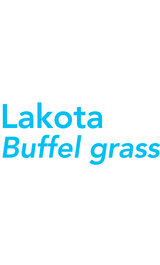Download a copy of the Lakota Buffel Grass factsheet.
Lakota, a tetraploid apomictic hybrid, is a new buffel grass (Cenchrus ciliaris) variety generated from a buffel grass breeding program in Texas USA. This strongly perennial variety was specifically selected for buffel leaf blight resistance, cold tolerance and improved agronomic performance such as forage yield and winter active regrowth. Leaf blades are thin, resulting in much finer textured vegetative growth compared to other commercial varieties. Maturity evenness of this variety provides higher protein feed late in the season. Lakota demonstrates exceptional recovery after grazing or cutting. Later flowering than other buffel grass types provides Lakota the ability to maintain feed quality longer and out yield similar varieties in the market place.
Agronomy/Management
Lakota Buffel is well suited to tropical, sub-tropical and warmer temperate regions. This variety is adapted to a wide range of soil types from infertile sands, lighter reds through to more fertile black soils. Though slow to establish on heavier black cracking clay soils, once established Lakota grows well. Cold tolerance allows Lakota to tolerate frost in western production areas well and offer good early feed coming out of the winter months, resulting in a longer growing season. Lakota buffel establishes and persists well, even at low fertility, having a higher tolerance for drought and a rapid growth rate compared to other tropical grass species. Unlike USA and Biloela susceptibility to buffel leaf blight, Lakota is resistant to this disease, vastly improving forage yield and quality under disease pressure in the field.
Establishment
Seed can be surface sown, broadcast or drilled and being a small seed, should be planted ideally at 5mm and no more than 1cm deep. Seed to soil contact is important. The use of press wheels or, on non-hard setting soils rolling after sowing, will greatly improve germination and establishment. Care should be taken not to plant in the hottest summer weather without adequate moisture – the seed must maintain close contact with wet soil for about 3–4 days to establish a seedling. The fluffy nature of buffel grass tends to result in the planting of bare seed becoming difficult using conventional machinery as seed does not flow readily and will clog planters. Drum seeders are more suitable. Coating seed makes it easier to handle and spread via both ground and aerial applications. The use of AgriCote coated seed will greatly improve the establishment success of Lakota.
Fertiliser/Nutrition
Buffel grass can survive and tolerate infertile soil, however will become unproductive and persistence will be reduced, particularly if grazed intensively. Buffel grass has a high demand for nitrogen and phosphorus. Seedlings require phosphorus for establishment. The use of AgriCote coated seed ensures essential macro and micronutrients are immediately available to the seedling. An application of 50–150kg/ha of superphosphate at planting is recommended, depending on soil type, fertility and rainfall. Generally it is uneconomical to apply fertiliser to extensive areas of buffel grass country – the use of a vigorous legume in the pasture can help to provide the nitrogen needs of buffel. Stand decline due to nitrogen rundown is common in buffel grass pastures. A maintenance fertiliser program is recommended to replace nutrient removed by grazing or hay cutting over time. The use of a soil test will form the foundation of a suitable fertiliser program.
Growth Habit
Low to medium growing, sprawling perennial tussocky grass with rhizome (underground stem) development. Has a deep, strong and fibrous root system to >2.0m.
Compatibility (with other species)
Lakota buffel performs well in a sole stand or in a balanced tropical mix. Combines with tropical grasses such as Rhodes grass, Panic, Brachiaria and Digitaria. Tropical legumes include Stylo, Wynn cassia, Burgundy bean, Siratro, Butterfly pea, Glycine, Centro, Desmanthus and Leucaena.
Uses
Lakota is an excellent option for extensive grazing, intensive grazing and for hay or silage if cut at a leafy stage. Also suitable for revegetation, erosion control and mine rehabilitation.
Persistence
Lakota is used as a permanent pasture. It is not suitable for a short term pasture option as it is slow to establish, difficult to remove and ties up nutrients. Buffel grass is one of the most persistent and drought hardy tropical grass species available. A larger seed head allows Lakota to produce a greater amount of seed over commercial buffel varieties. Very tolerant of, and favoured by fire, with the coverage of buffel increasing and populations of associated fire susceptible species decreasing under a fire regime. This variety generally has poor shade tolerance.
Toxicity
Buffel causes the condition ‘big head’ in horses due to high oxalate content at certain stages of plant growth.
Management
The success of a pasture will depend on grazing management in the first season. Buffel grass is slow to establish and grazing may need to be delayed during the first year depending on establishment conditions. Ideally it is best to avoid grazing in the first year until after seed set, which ensures plants are well established and provides lighter plant stands the ability to thicken. Once established, buffel grass is very tolerant of regular grazing or cutting. Quality declines rapidly with age, so buffel grass should be grazed regularly and heavily to maintain the grass in a leafy, more nutritious state.
Suggested Sowing Rates (AgriCote coated seed)
Marginal dryland: 4−6kg/ha
Ideal dryland: 8−12kg/ha
Irrigated: 15−20kg/ha
Plant Breeder Rights (PBR): This variety is registered under Plant Breeders Rights (PBR) in Australia. Unauthorised commercial propagation or any sale, conditioning, export, import or stocking of propagating material is an infringement under the Plant Breeders Rights Act (1994). Any breach of this legislation will leave the grower liable for prosecution.
Disclaimer: The information presented in this brochure is from official and other sources and is considered to be reliable. It is provided in good faith and every care has been taken to ensure its accuracy. Barenbrug does not accept any responsibility for the consequences that may arise from the acceptance of recommendations or the suggestions made.



